Dortmund
Dortmund [![]()
![]() ˈdɔʁtmʊnt] (standard pronunciation; regional: [ˈdo:ɐ̯tmʊnt]; Westphalian Düörpm) is an independent city in North Rhine-Westphalia and, with 588,250 inhabitants, the ninth-largest city in Germany, as well as the third-largest city in North Rhine-Westphalia after Cologne and Düsseldorf. Dortmund is part of the Rhine-Ruhr metropolitan region with about eleven million inhabitants, by area and population the largest city in the Ruhr area and is considered the administrative, commercial as well as cultural center of the eastern Ruhr area. The city is located in Westphalia and is part of the administrative district of Arnsberg.
ˈdɔʁtmʊnt] (standard pronunciation; regional: [ˈdo:ɐ̯tmʊnt]; Westphalian Düörpm) is an independent city in North Rhine-Westphalia and, with 588,250 inhabitants, the ninth-largest city in Germany, as well as the third-largest city in North Rhine-Westphalia after Cologne and Düsseldorf. Dortmund is part of the Rhine-Ruhr metropolitan region with about eleven million inhabitants, by area and population the largest city in the Ruhr area and is considered the administrative, commercial as well as cultural center of the eastern Ruhr area. The city is located in Westphalia and is part of the administrative district of Arnsberg.
Presumably dating back to a Carolingian imperial court foundation, the once important imperial and Hanseatic city (Tremonia in Latin) along the Hellweg is today developing from an industrial metropolis into an important service and technology location: formerly known primarily for steel, coal and beer, Dortmund is now a centre of the insurance industry and retail trade after many years of structural change. With around 53,500 students at six universities, including the Technical University of Dortmund, and 19 other scientific institutions, Dortmund is one of the ten largest university cities in Germany and is also an important science and high-tech location. As a result, new settlements and start-ups are being established primarily in the fields of logistics, information technology and microsystems technology. The Ruhr metropolis has a diverse cultural scene with numerous museums and galleries such as the Museum Ostwall, the Museum of Art and Cultural History or the German Football Museum. In addition, there is the Theater Dortmund with opera house, the award-winning Schauspielhaus and the children's and youth theatre as well as the Konzerthaus.
With its main railway station and airport, Dortmund is an important transport hub and centre of attraction, particularly for the surrounding region and Europe (Benelux countries), and with Europe's largest canal port has a connection to important seaports on the North Sea. Dortmund is known nationwide for its football club Borussia Dortmund and its home ground Signal Iduna Park, the former Westfalenstadion. With over 81,000 spectator seats, it is the largest football stadium in Germany. Other attractions and landmarks of the city are the Dortmunder U, the Westenhellweg as one of the most frequented shopping streets in Germany, the Reinoldikirche, the Westfalenhalle, the Florianturm and the Phoenix-See. The cityscape and skyline are also characterised by striking skyscrapers. In terms of tourism, the city is gaining in importance every year, with over 1.44 million overnight stays in Dortmund in 2019; this represents a growth rate of 6.5 percent.
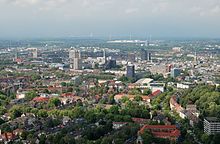
View from the Florianturm to the city centre of Dortmund.
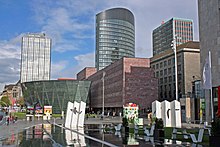
View of the center of Dortmund. From left to right: IWO high-rise, City and State Library, RWE Tower, Dortberghaus, Sparkassen high-rise. In the foreground the Platz der Deutschen Einheit at the German Football Museum.
Geography
Location
Dortmund is located at 86 m above sea level, 51° 30′ 51″ N, 7° 27′ 50″ E51.51416666677.46388888986. The Dortmund district of Aplerbecker Mark is even located in the middle of North Rhine-Westphalia with the coordinates 51° 28′ 42″ N, 7° 33′ 18″ O51.47833333337.555, according to the State Survey Office of North Rhine-Westphalia. In Dortmund, as in all of Germany, Central European Time applies, the mean local time remains 30 minutes and 7.7 seconds behind this.
Dortmund lies in the southwest of the Westphalian Bay, the southern extension of the North German Plain on the border to the German low mountain range; to the south rise the foothills of the Sauerland and the Ardey Mountains, to which the Dortmunder Rücken in the east of the city is counted as the northernmost elevation. Behind this lies, as part of the Hellwegbörden, the Werl-Unnaer Börde, to the north the Lippe valley and the Lipper heights in the Münsterland border. The west is determined by the Ruhr conurbation, to whose eastern, Westphalian part Dortmund belongs.
The city centre of Dortmund lies on the border between the northern lowlands and the southern hills, the so-called Westphalian Hellweg; accordingly, the city is part of the natural areas of the Hellwegbörden and the Westenhellweg. Since the upper reaches of the Emscher also flow through Dortmund, it is also part of the Emscherland natural area further north. In the south, below Hohensyburg Castle, the middle course of the Ruhr forms the city boundary, into which the Lenne flows on Hagen territory, where it forms Lake Hengstey. The Dortmund-Ems Canal, which leads to the north, also begins in Dortmund's city harbour.
Waters
The Dortmund urban area is relatively poor in natural bodies of water. Apart from the Ruhr in the south of Dortmund on the city border with the cities of Hagen and Herdecke, the larger flowing waters include only the river Emscher, which runs from east to west through the city area. In addition, there are numerous smaller streams such as the Hörder Bach, Rüpingsbach, Schondelle, Roßbach or Körnebach, which flow into the first-mentioned rivers or belong to the catchment area of the Lippe. Many of the streams were used for sewage disposal, but were gradually restored to their natural state in the course of the Emscher renaturation by the Emschergenossenschaft. The renaturation has considerably improved the environment of the streams. In addition, the Dortmund-Ems Canal (DEK, watercourse code: 70501) is a federal waterway between Dortmund's city harbour and Papenburg/Ems.
With the Hallerey, the Lanstroper See, the Pleckenbrinksee and the Brunosee in the Beerenbruch nature reserve, four lakes are closely linked to the mining history in Dortmund. These bodies of water were created by mining subsidence. Two further lakes, Lake Hengstey and Lake Phoenix, were artificially created.
Extension
The urban area of Dortmund covers 280.707 km². This puts Dortmund in 26th place among the municipalities with the largest area in Germany, and in ninth place among large cities. Its area is surpassed in North Rhine-Westphalia only by the major cities of Cologne and Münster and the town of Schmallenberg.
The northernmost point of Dortmund lies between the district of Groppenbruch and Lünen-Brambauer on the territory of the former municipality of Schwieringhausen (51° 36′ 5″ N, 7° 25′ 11″ O51.60138888897.41972222222), the southernmost 21 km from it opposite the mouth of the Lenne (51° 25′ 1″ N, 7° 29′ 38″ O51.41694444447.49388888889), the easternmost point of Dortmund is north of the airport in the district of Wickede and borders on Unna-Massen (51° 31′ 44″ N, 7° 38′ 20″ O51.52888888897.63888888889), the westernmost 23 km from it in the district of Holte on the border with Bochum (51° 30′ 32″ N, 7° 18′ 12″ O51.50888888897.30333333333). Roughly, these two axes can be thought of as diagonals of a square that forms Dortmund's urban area. Dortmund's highest elevation is the Klusenberg, located in the Syburg district, at 254.33 m above sea level; the lowest point is 49.5 m above sea level in the Derne district.
Neighboring communities
Dortmund is bordered for 21 km by the district of Recklinghausen with the cities of Castrop-Rauxel in the west and Waltrop in the northwest. From north to south-east, Dortmund is surrounded for a total of 76 km by the district of Unna with the cities of Lünen in the north, Kamen in the north-east, Unna in the east, the municipality of Holzwickede and the city of Schwerte (both in the south-east). This is followed by the city border of the independent city of Hagen, which is only two kilometres long, directly to the south. In the southwest of Dortmund, the city borders the Ennepe-Ruhr district with the cities of Herdecke and Witten over a distance of 17 km. Finally, the district-free city of Bochum lies exactly to the west, and the city boundary here is ten kilometres long. In total, the Dortmund city boundary thus covers 126 km.
Political geography
→ Main article: North Rhine-Westphalia and list of Dortmund districts
Dortmund is historically a part of Westphalia and is now located in the federal state of North Rhine-Westphalia. The city is district-free and lies in the area of the administrative district of Arnsberg. It belongs to both the Landschaftsverband Westfalen-Lippe and the Regionalverband Ruhr. It is also a member of other special-purpose associations such as the Rhine-Ruhr transport association, the Ruhrverband, the Emschergenossenschaft and the Lippeverband. Dortmund is a major centre of North Rhine-Westphalia and part of the European Rhine-Ruhr metropolitan region. It is one of the four major centres of the Ruhr region, along with Essen, Duisburg and Bochum, all of which are located in the so-called Hellweg zone.
Since 1 January 1975, the city of Dortmund has been divided into twelve city districts.
These are the three inner city districts West, North and East as well as the ring surrounding them consisting of the nine other districts Eving, Scharnhorst, Brackel, Aplerbeck, Hörde, Hombruch, Lütgendortmund, Huckarde and Mengede clockwise (starting in the north). Each of these boroughs elects a district council at the local elections and this council elects a district mayor from its ranks. In the outer districts there are also district administration offices.
Below the city districts, the city is further divided into 62 statistical districts and these in turn into a total of 170 statistical sub-districts. Outside of the inner city districts, these often correspond to the formerly independent localities incorporated into the city of Dortmund. In addition to this official division, there are also the urban districts listed below.
Climate
Dortmund, like the whole of Germany, lies in a temperate climate zone. The city is assigned to the northwest German climate zone and is located on the border between the climate districts of Münster and Sauerland and thus in the transition area between Atlantic-maritime and continental climate.
Mild winters and relatively cool summers are characteristic. The average annual temperature is 9-10 °C, the average precipitation over many years is 750 mm. The predominant wind direction is southwest. Precipitation is distributed fairly evenly throughout the year, with persistent rain dominating in winter and shorter but more abundant rain showers in summer. Accordingly, the maximum is reached in July with 80-90 mm, the minimum is 40-50 mm in February. Temperature fluctuations are also rather low at under 20 °C, the coldest month is January with -6 to 11 °C, the warmest month is August with 10-35 °C. In Dortmund, climatic characteristics of densely populated areas are evident, for example, heat islands typical of an urban climate are formed.
| Dortmund | ||||||||||||||||||||||||||||||||||||||||||||||||
| Climate diagram | ||||||||||||||||||||||||||||||||||||||||||||||||
| ||||||||||||||||||||||||||||||||||||||||||||||||
| Monthly average temperatures and precipitation for Dortmund
Source: | ||||||||||||||||||||||||||||||||||||||||||||||||||||||||||||||||||||||||||||||||||||||||||||||||||||||||||||||||||||||||||||||||||||||||||||||||||||||||||||||||||||||||||||||||||||||||||||||||||||||||||||||||||||||||||||||
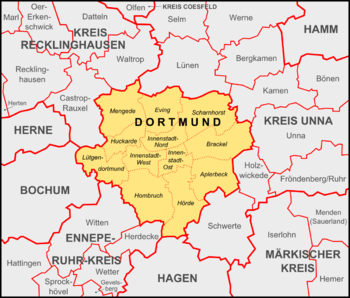
Boroughs and neighbouring municipalities of the city.
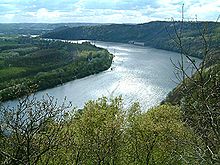
View from the Hohensyburg to the Hengsteysee

Emscher in Dortmund
Demographics
→ Main article: Population development of Dortmund
Statistical overview
On 31 December 2020, 587,696 people lived in Dortmund. This puts Dortmund in 41st place among the largest cities within the European Union, in 9th place within Germany and in third place in North Rhine-Westphalia as the largest city in the Ruhr region behind Cologne and Düsseldorf. Dortmund is part of the European Rhine-Ruhr metropolitan region which, with a good 10 million inhabitants, is the fifth largest agglomeration in Europe after the agglomerations of Moscow, London, Paris and Istanbul. Within this metropolitan region, Dortmund is part of the Ruhr conurbation and merges smoothly with the other cities of the Ruhr area, particularly in the west. In turn, around 4.95 million people live in the area of the Regionalverband Ruhr, the Ruhr Area's special-purpose association, alone. The number of inhabitants results in a population density of 2,087 inhabitants per km². This puts Dortmund in 39th place in Germany among the municipalities with the highest population density.
Outside the inner city area, there are significantly fewer people per square kilometre than in the inner city. In 2013, the figures ranged from around 1,460 inhabitants per km² in the statistical sub-district of Holthausen (Eving borough) to around 39,180 inhabitants per km² in the statistical sub-district of Nordmarkt-Südost (Innenstadt-Nord borough).
Population structure
| Largest groups of residents without German citizenship | |
| Nationality | Inhabitants |
| Turkey | 21.023 |
| Syria | 12.288 |
| Poland | 9.568 |
| Romania | 5.832 |
| Spain | 4.992 |
| Bulgaria | 4.659 |
| Greece | 4.165 |
| Italy | 3.904 |
| Morocco | 3.239 |
| Iraq | 2.952 |
| Croatia | 2.474 |
| Serbia | 2.418 |
| North Macedonia | 2.360 |
| Ukraine Ukraine | 2.192 |
| Bosnia and Herzegovina | 1.984 |
| Russia | 1.905 |
| Portugal | 1.818 |
| Kosovo | 1.603 |
| China People's Republic of | 1.356 |
| Hungary | 1.335 |
| other | 23.047 |
| total | 115.458 |
| of which from the | 42.473 |
In 2020, 50.4% of the population were women and 49.6% were men.
Already in the Middle Ages Dortmund was a city of immigration, but with the beginning of industrialization the influx increased enormously. Among these immigrants were also many Poles and thus for the first time a large group of non-German speakers with a different religion, who however gradually assimilated. Further targeted recruitment of guest workers took place, especially in the 1960s, to meet the demand for labour in the coal and steel industry. The proportion of foreigners in the city is 19.1% (as of 31 December 2020). This is an average figure for large cities in western Germany. The proportion of people with a migration background (regardless of citizenship) was 35.6% at the end of 2018.
Similar to the population density, there are clear differences within the city area: the highest proportion of foreigners tends to be in the city districts and neighbourhoods in the north of Dortmund. For example, as of 31 December 2020, almost one third of all foreigners in Dortmund lived in the city district of Innenstadt-Nord. The proportion of foreigners here is 54.0% overall. A relatively large number of foreigners also live in many other outer districts of Dortmund North, such as Lindenhorst (32.2%), Scharnhorst-Ost (31.4%), Eving (31.3%) and Derne (24.5%). The proportion is also relatively high in many districts in the west of Dortmund, such as Westerfilde (27.7%), Nette (24.3%) and Huckarde (20.7%). The proportion of foreigners tends to be lower in the east and south of Dortmund. However, a relatively large number of foreigners live in Hörde (23.6%). There are major differences between the various nationalities in Dortmund; for example, the proportion of EU citizens among foreigners is significantly higher on the outskirts of the city. A special group among the foreigners in Dortmund are the foreign students enrolled at the universities: they are usually only in the city for a short period of time and come to a large extent from Asia and Africa. In total, around 53,500 students were enrolled at the city's six universities in the winter semester 2017/2018.
In 2018, 40.2% of residents were married, 43.7% were single, 6.9% were widowed, and 8.1% were divorced.
Income and benefit structure
On 31 December 2016, 88,696 Dortmund residents received transfer payments under Book Two of the Social Code (Arbeitslosengeld II, Sozialgeld), or 15.1% of the total population.
Dortmund's unemployment rate was 11.0% at the end of June 2017. There are large differences within the city area.
In the north of Dortmund there are many districts with a high proportion of welfare recipients and unemployed. This applies in particular to all statistical districts of the city district Innenstadt-Nord (unemployment rate of 21.3 %), but also to districts located outside the city centre, such as Scharnhorst-Ost (18.9 %), Eving (14.7 %) and Lindenhorst (13.6 %). Nevertheless, there are also some districts in the north with low unemployment rates and high average incomes, such as Brechten, Holthausen and the north-eastern districts of Husen, Kurl and Grevel.
The social structure in the districts of western Dortmund is relatively mixed. In many places, unemployment rates are roughly in line with the Dortmund average or slightly higher, for example in the larger districts of Huckarde (12.8%), Kirchlinde (12.5%) and Lütgendortmund (11.2%). Deusen and the suburban areas of Oespel and Westrich in particular have low unemployment rates and higher income structures. In other parts of the west, however, such as Westerfilde (16.5%), Nette (15.7%) and Marten (14.3%), unemployment is well above average.
The eastern part of Dortmund has predominantly districts with low unemployment rates and average or slightly higher income structures. With the exception of Wickede (12.0 %), which lies on the outskirts of the city, unemployment rates in the east are always below the Dortmund average. Unemployment is relatively low in some of the larger districts, such as Aplerbeck (6.4%) and Asseln (6.1%), as well as in smaller districts, such as Sölderholz (3.6%).
Dortmund's south is home to a particularly large number of districts with low unemployment rates and higher income structures. This applies in particular to the southern districts of Brünninghausen, Lücklemberg, Kirchhörde and Bittermark, which lie directly west of the B 54, and to the south-eastern districts of Aplerbecker Mark, Höchsten, Holzen, Wichlinghofen and Syburg, which lie along Wittbräucker Straße. Only Hörde has higher unemployment (14.8%). The social structure is relatively average in Hombruch, for example.
The average age of the Dortmund population is about 43 years. The youth dependency ratio, i.e. the ratio of people under 20 years of age to the employable population, is 34.5, the old-age dependency ratio, i.e. the proportion of people aged 60 or more in relation to the employable population, is 47.0, and the dependency ratio of employable to non-employable population is therefore about 5:4. These are values that can also be found for the whole of Germany.
Population development
→ Main article: Population development of Dortmund
In 1895, the city of Dortmund exceeded 100,000 inhabitants, which made it a large city. After the incorporation of the city of Hörde and the districts of Dortmund and Hörde, about 536,000 people lived in the city in 1929. The Second World War depopulated the destroyed Dortmund. In April 1945, 340,000 people were counted. Afterwards, many people who had been evacuated to the surrounding countryside as well as refugees and displaced persons settled in Dortmund. The number of inhabitants increased rapidly. In 1965 a peak was reached with 657,804 citizens. In the years that followed, the population declined, as it did in the surrounding cities of the Ruhr area. Thus, the 1987 census recorded a population of 584,089. However, this trend has now reversed. Thus, the population has been rising again for several years, to 588,250 official inhabitants as of 31 December 2019. The State Office for Information and Technology of North Rhine-Westphalia (IT.NRW) forecasts a 5.1% increase in the population of Dortmund to 604,100 people by 2040.
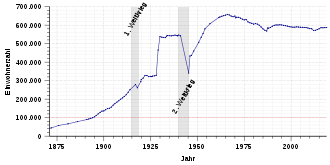
Population development from 1871 to 2018
Search within the encyclopedia